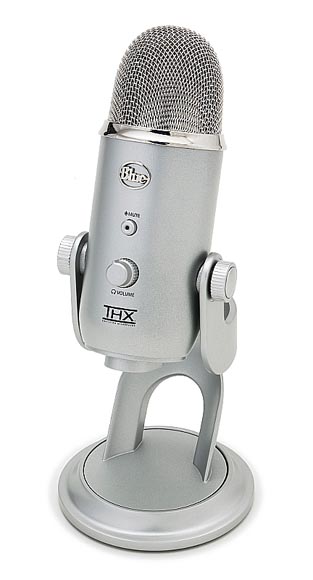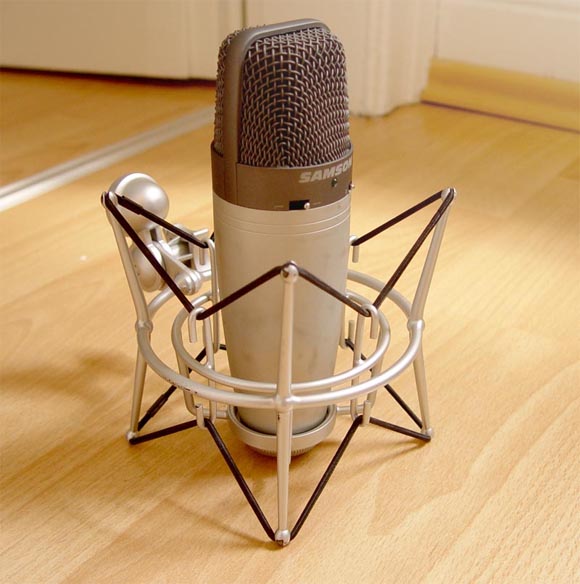This is the story of my CO3U Microphone. I’m selling it on eBay right now.
It’s about 1,5 years ago that I bought me a microphone. I had no clue about microphones. I wanted something simple and flexible to record the Podcast with. I ended up with the Samson CO3U. Considering how clueless I was, I was lucky. It turned out to be a very cool, flexible microphone that had a lot of nice features to experiment with. Little did I know how an important role it would play.
But the start was jumpy. The podcast didn’t go so well (Note to myself: Remove that button on this Website) and and I was a bit disappointed to see the mic just collect dust.
But soon after I was about to record the vocals for TRAUMA. I had the CO3U ready as a backup. But I was actually going to use a super-expensive fancypants Sennheiser they had at the university studio I recorded at. Except I didn’t. The Sennheiser was an XLR mic that had to be wired through one of those crazy complicated mixing tables. The problem was that I had no clue how the mixing table worked. The guys at the studio apparently didn’t either. The recording didn’t work at all. The voice didn’t come out loud enough. We turned every knob, but time was ticking. The actors I made the appointment with were getting impatient.
That’s when I whipped out the CO3U. It’s a simple USB mic that doesn’t require any mixing tables. I had it up an running in a couple of seconds and we ended up doing ALL of the recodings for TRAUMA on just this mic.
Now to be honest, I wasn’t blown away by the quality when back when I got the first. We did our first podcast recordings in my living room. It turns out my living room has the WORST acoustic properties in the world. It’s an old flat with a high ceiling and narrow walls. There is a ton of reverb. It took a couple of sessions to figure out how to get a good sound out of the mic.
The TRAUMA recordings were done in a padded studio cell but there were some super loud renovations going on in the background and my main actress – Anja Jazeschann – had whisper to get that dreamy voice. Considering the conditions, I was quite pleased with what the backup mic produced. You can hear the results for yourself. It certainly saved the day.
I continued using the mic for a year doing our weekly Monster Hunter Podcast. I used the mic in every show up to and including episode 40. During that time, I grew quite comfortable with it. I learned how to get around the reverb in my living room (by speaking into it very closely) and how to post-process the recordings so that everything sound well. The CO3U is just the right mic to experiment with. It has tons of switches for 3 different recording patterns, a built-in highpass and a -10db pad. It was a pleasure working with it.
Recently I decided to move on and experiment with changing my setup. I heard that a lot of people use the Blue Snowball. It had one feature the CO3U didn’t seem to have – some slight built-in compression. This means that the mic is less sensitive to variations in loudness. I decided to give it a try. You can hear the results in the Monster Hunter Podcast Episode 41. I wasn’t happy. My voice sounded remote and dull. To be fair, I do realize that this is just the usual learning curve with the mic. I did some recordings afterwards and they sounded much better. I also liked the compression that brought me to the mic in the first place. However, the Snowball was a bitt less flexible than the CO3U. For example, it didn’t have a figure eight pattern for recordings of interviews. And hearing the results of shows like the Day9 Daily and the Experience Points Podcast (both use the Snowball), I was somewhat let down. I expected epic win out of the box.

What I tried first: The Blue Snowball. Result: meh.
What I realized is that good sound recordings take a lot of experience. They require you to learn the limits and strengths of whatever you use. But of course now the Pandora’s Box has been opened. I’m still dedicated to move on from the CO3U. I liked the compression on the Snowball but since I will need to re-learn everything, I was tempted to see how deep this rabbit hole goes. I exchanged the Blue Snowball for the just slightly more expensive Blue Yeti. It seems to have similar characteristics but has more settings to fumble around with. It’s what I liked about the Snowball and what I liked about the CO3U. I did some tests and so far I’m pleased with what I’m hearing. I will post some more soon.

What I ended up with: The Blue Yeti. Much better. I think I can make this work.
But until then, you are invited to bid for my trusted CO3U. It’s a good, solid mic for podcasts and voice recordings. I had a lot of fun with it and as you can see it served me well. It’s still in superb condition, in spite of the patina it acquired. And if you want, I will even sign it. Hey, that autograph may be worth a ton some day. ![]()
P.S.: Don’t mind the white lies in the eBay description. I will continue podcasting!







